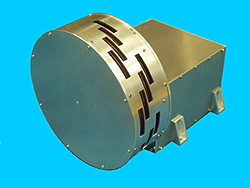Instruments
Summary
The Double Star payload includes eight European instruments and eight Chinese instruments. Seven of the eight European instruments are identical to the ones on Cluster with one, the Neutral Atom Imager, newly built for TC-2.
- Active Spacecraft Potential Control (ASPOC)
- Fluxgate Magnetometer (FGM)
- Hot Ion Analyser (HIA)
- Plasma Electron and Current Experiment (PEACE)
- Spatio-Temporal Analysis of Field Fluctuations and Digital Wave Processor (STAFF/DWP)
- Neutral Atom Detection Unit (NUADU).
Each instrument is built by a team under the leadership of a Principal Investigator (PI). The two instruments FGM and PEACE are built for both TC-1 and TC-2.
Instruments on-board TC-1 and TC-2
| TC-1 (Equatorial Double Star) | TC-2 (Polar Double Star) | ||
| Instrument | PI | Instrument | PI |
| ASPOC |
K. Torkar IWF Graz Austria |
NUADU |
S. McKenna-Lawlor STI Ltd. National University of Ireland Co. Kildare Ireland |
| FGM |
C. Carr IC United Kingdom |
FGM |
T. Zhang IWF Austria |
| PEACE |
A. Fazakerley MSSL Dorking United Kingdom |
PEACE |
A. Fazakerley MSSL Dorking United Kingdom |
|
HIA [Sensor 2 of CIS] |
H. Rème CESR Toulouse France |
Low Energy Ion Detector (LEID) * |
Q. Ren & CSSAR China |
| STAFF/DWP |
N. Cornilleau- Wehrlin & H. Alleyne |
Low Frequency Electro-magnetic Wave Detector (LFEW) * |
Z. Wang & CSSAR China |
|
High Energy Electron Detector (HEED) * |
CSSAR China |
High Energy Electron Detector (HEED) * |
CSSAR China |
|
High Energy Proton Detector (HEPD) * |
J. Liang & CSSAR China |
High Energy Proton Detector (HEPD) * |
J. Liang & CSSAR China |
|
Heavy Ion Detector (HID)* |
Y. Zhai & CSSAR China |
Heavy Ion detector (HID)* |
Y. Zhai & CSSAR China |
|
NOTE: '*' indicates the instrument originated in China
|
|||
ASPOC
Principal Investigator: Klaus Torkar, Austria
Electrical charging of a spacecraft in orbit can have a severe impact on the performance of the scientific instruments. ASPOC (Active Spacecraft Potential Control) is designed to 'earth' or neutralise the spacecraft by preventing a build up in positive electrical charge. It does this by emitting ions (charged particles) of the metal indium into space through a small needle. These ions cancel out the electrical charge that the satellite acquires. The ion current is adjusted by using measurements made by PEACE, which record the spacecraft's electrical potential.
|
|
|
The ASPOC instrument |
FGM
Principal Investigators: Chris Carr, UK and Tielong Zhang, Austria
Located on a 3.5 metre long boom to avoid interference from the spacecraft, two magnetometers measure the magnetic fields along the orbit. FGM (Fluxgate Magnetometer) can take high resolution measurements with up to 67 samples per second. Two instruments are built, one for the equatorial spacecraft and one for the polar spacecraft.
|
|
|
The FGM instrument |
HIA
Principal Investigator: Henri Rème, France
Analyses the distribution functions of ions in the nearby (magnetosphere) space plasma and in the solar wind, during each four second spin of the spacecraft. (Space plasma is a gas composed of electrically charged particles, mainly electrons and protons plus some other ions.) HIA (Hot Ion Analyzer) is one of the two spare sensors from the Cluster mission.
 |
|
The HIA instrument |
NUADU
Principal Investigator: Susan McKenna-Lawlor, Ireland
An advanced particle detector that is designed to monitor energetic neutral atoms (ENAs) in the Earth's magnetosphere. ENAs in the Earth's magnetosphere are produced via charge exchange between singly - charged magnetospheric ions and atoms of the exosphere. Since they propagate unaffected by electric and magnetic fields, ENAs can be used to image, and remotely diagnose plasma populations immersed in the neutral gas within which they are created. The main scientific objective of the NUADU (Neutral Atom Imager) experiment is to perform energetic neutral atom (ENA) imaging of the Earth's Ring Current.
 |
|
The NUADU instrument |
PEACE
Principal Investigator: Andrew Fazakerley, UK
Like CIS, this experiment also sifts incoming particles. PEACE (Plasma Electron and Current Experiment) looks at all electrons in the space plasma which have low to medium energies, counts them and measures their direction of travel and speed. The Cluster spare instrument has been split into two instruments: one sensor is on board the equatorial spacecraft and the other is on board the polar spacecraft.
 |
|
The PEACE instrument |
STAFF/DWP
Principal Investigators: Nicole Cornilleau-Wehrlin, France and Hugo Alleyne, UK
A magnetometer on the end of a 3.5 metre long boom looks at waves (rapid variations in the magnetic fields), particularly in regions where the charged particles of the solar wind interact with the magnetosphere. Low frequency data are analysed on the ground, while the magnetic components of the higher frequency waves are processed on board. It also has a particle correlator that enables variations in the electron population around the spacecraft to be compared with the wave measurements. The instrument flies on board the equatorial spacecraft.
 |
|
STAFF/DWP (Spatio-Temporal |


